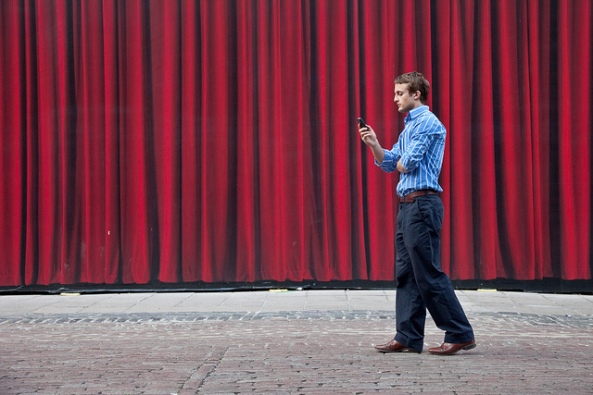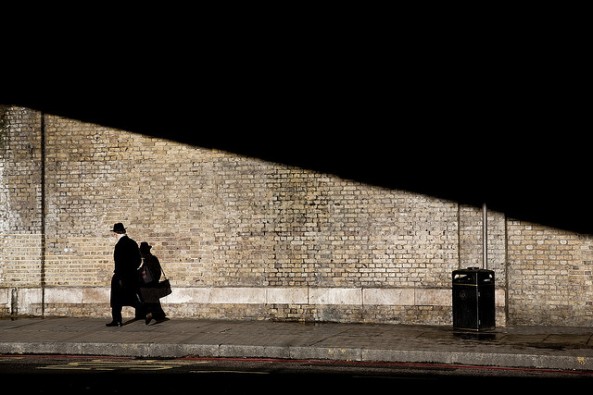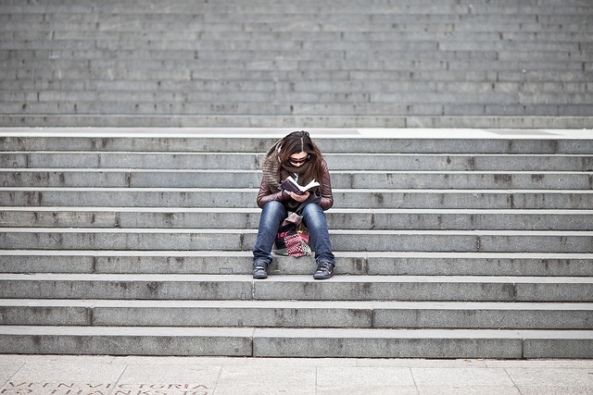
Tom’s photography is a comment on everyday life in this loud and bustling London city. “The decisive moment” is what he is most intent on capturing and that is exactly what he excels at doing. He’s an observer, a documentary photographer who focuses on the raw presentation of reality through his work – of Londoners on their daily commute, of moments of solitude and anonymity, of reflection and people lost in thought.
Originally from Lublin, Poland, Tom completed an MA in Culture and Psychology Studies at UMCS in his hometown before coming to London. He works as a corporate and event photographer with the Polish Embassy in London and Polish Professionals Association as well as being an official Getty Images contributor. His photography has been published in several online and print magazines and he has won a few awards including the Flora London Marathon Photography Award and the Panasonic Lumix Award.
For this week’s London Art Spot, Tom tells us about how London life – particularly his South Bank/Bankside neighbourhood – influences his photography, talks about his approach to his subjects and the challenge he constantly has to overcome and shares some of his favourite London shots.
LLO: How long have you lived in London and what brought you to this lively city?
TK: I came to London first time 6 years ago and… didn’t like it really – was far too busy for me! But a year after that I received an interesting job offer so I decided to give London a second chance and it actually worked well. It’s my 5th year here and I’m still excited and surprised by this city. It’s a great place for a photographer – an endless source of inspiration with all the galleries, vibrant streets, amazing cityscape and interesting people from around the world. A great source of inspiration!
LLO: What influence has moving to London had on your approach to photography?
TK: I’ve actually discovered “serious” photography in London – before moving here, I wasn’t thinking or reading too much about photography. Now it’s almost permanent: there’s no single day without at least a small activity related to the photography. Uploading photos to my Flickr account (http://flickr.com/klbw), reading about photography, thinking about new projects… I love it and it’s like a meditation to me, it keeps me sane and let’s me constantly progress in the photography field.
LLO: Favourite place in London to take your camera and why?
TK: A lot of them, but the one I’m most familiar with is my neighbourhood: Bankside and South Bank area. I’ve spent there so much time with the camera, took thousands of photographs and I know that place so well, yet it still seems fresh and inspiring! It’s different at various seasons or time of day, there’s a lot of nice hidden places if you go away from the main touristy river bank route. Two of my ongoing projects are strongly related and sort of dedicated to that area.
LLO: What’s the biggest challenge you’ve had to overcome to get a great shot?
TK: My photography style is not technically complicated or demanding in terms of equipment, I use a simple set of camera and standard lenses. Also I’m interested in documenting the reality in a possibly faithful and objective way (if possible at all with photography, but that’s a theme for another discussion). Therefore the challenges I encounter are usually related to my approach and general style of work. I work quickly and in “stealth” mode – I try not to disrupt people I photograph and do not influence the reality I want to capture. It’s important to be invisible to my objects, so I can get exactly the picture I see, and not the picture of their reaction to me. This is to me the essence of the photography: telling the stories that would exist if unframed by your eye and the camera. So basically my main challenge is finding the decisive moment without interacting with the reality I encounter.
LLO: You say you have a special focus on solitude in the crowd and anonymity in big city. How do you approach these topics with your camera? Are there specific elements you look for when you compose an image?
TK: Issues of solitude and individuality in the crowd fascinate me and they are especially visible in the metropolis like London. My approach is not to portray pathology or a problem – it’s more about keeping individuality and appreciating yourself, finding your own space and time for yourself in this usually busy, fast and noisy city. My objects usually seem to be happy and in a right place, just where they want to be, spending time with themselves. I try to compose my objects isolated against the city background, usually I use a very shallow depth of field to achieve that. The city landscape is always there and it stays significant, but the person is my main focus – a leading character of the story.
LLO: Are there any London-based photographers you really admire?
TK: Of course! I love to see London through the eyes of other photographers, it’s a great experience and exercise in seeing too. David Solomons, Nick Turpin, Matt Stuart, Stephen McLaren are some of my favourites. I like their approach to street photography: deep, smart and elegant but at the same time light and funny. Their imagination, observation skills and sense of decisive moment are impressive.
LLO: Share your favourite image of London that you’ve captured so far and tell us what makes it special to you.
TK: It changes every now and then, but recently I really appreciated this picture: St Paul’s (http://www.flickr.com/photos/klbw/4588387091/). It was taken in the one and only snowy day last year at Bankside, next to the Millennium Bridge, overlooking St Paul’s Cathedral. I love the dreamy mood of the background and the dynamics of the foreground as well as the tiny detail like the bits of snow floating behind the bird. It’s simply composed and well timed. It’s not my typical photograph and probably not most typical capture of London either, but that’s the one that says a lot about my own vision of that city, not necessarily realistic.
LLO: What are you working on now?
TK: I’m finishing two projects – one is the solitude/individuality in the metropolis that I’ve mentioned earlier – between 15 and 20 large colour prints. Another one is a collection of my street photographs taken within last few years in London. Both will be presented in a form of exhibition later this year, maybe a self-published book too. Meanwhile some of the photos are available to view on my website: www.kulbowski.com.
Thanks Tom!
For more London Art Spot interviews, click here.


















